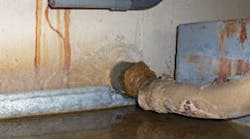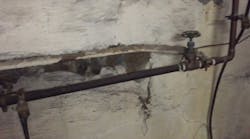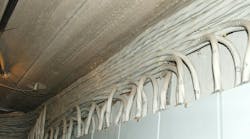As usual, never consider the following commentary associated with these photos as a formal interpretation of the National Electrical Code (NEC). Without criticizing anyone or any product, the following scenarios present us with serious safety questions.
All references are based on the 2005 NEC.
Water, Water — Everywhere Trenton E. Schaaf, E.I.T., a project engineer with E/B/E, Inc., in Houston, thought EC&M readers might get a kick out of these photos. His firm was called in to help engineer a fix at a bank where the electrical room (located in the basement) had been subjected to numerous water infiltrations over the years.
“As you can see, previous attempts to stop the leaks were unsuccessful,” said Schaaf. “Every one of the electrical conduits that pass through the foundation walls fills up with water every time it rains. The two large flex conduits for the secondary of the transformer allow water to flow directly into the equipment. It's amazing there hasn't been a fault condition yet. Note how the 4-inch conduit has separated at its connection point to the outside PVC, and someone tried to patch it with pipe putty. Also note the electrolysis scars on the EMT. The most interesting ‘fix,’ however, has to be the installation of a PVC ‘drain’ in the ¾-inch conduit. Incredibly, this arrangement hasn't led to a serious incident, yet. Any person entering this room during a rainstorm would be placed at immediate and extreme risk.”
Using a toilet wax ring (or whatever material that is) to plug up the leaking pipe — and a plumbing tee into a stub to collect the water that found its way into the electrical raceways — is not an approved construction method. Neither are those rubber hose clamps, which we all know do not assure grounding and bonding continuity. Here's a list of just a few rules not being observed in this installation — 110.12(C), 250.2, 300.12, and Art. 250.
Found a Code Violation? E-mail your photos to Joe Tedesco at [email protected].





